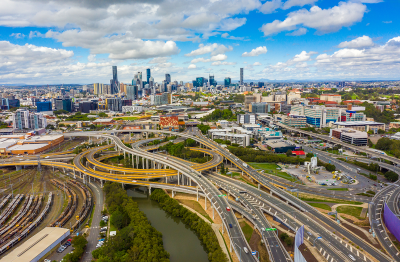Overview
It’s crucial for our economy and our standard of living that Queensland has effective, well-maintained infrastructure in place when and where it is needed. The Queensland Government commits significant funding each year to the delivery of infrastructure, and the annual state budget includes information on spending on proposed projects by each government entity. The Brisbane 2032 Olympic and Paralympic Games has the potential to deliver many social and community benefits over many years. There is much to consider when it comes to investing in infrastructure for our state and maximising these benefits.
Tabled 1 December 2022.

Report on a page
Queensland needs infrastructure that is effective, well-maintained, and in place when and where it is needed. It is important for our economy, our standard of living, and our communities. All levels of government commit significant funding each year to the delivery of infrastructure. The annual state budget includes information on spending on proposed projects by each government entity.
This audit brief provides details on Queensland’s major infrastructure projects and analyses expenditure by the Queensland Government.
Infrastructure is costly to deliver. When making decisions about investing in it, governments must consider the community’s needs, as well as possible changes to expectations, population, and technology. In the last 5 years, the largest portion of the Queensland Government’s expenditure on infrastructure has been on transport (including rail and roads), followed by energy, education, and health. This has mainly been within the south-east of the state, which has a larger population and is expected to have higher population growth than the rest of Queensland.
Over the last 5 years, budgeted capital expenditure has increased from $9.9 billion in 2018–19 to $12.6 billion in the 2022–23 budget. This does not yet include future projects for the Brisbane 2032 Olympic and Paralympic Games, which will involve all levels of government. The Games should deliver many social and community benefits over many years, and we will continue to review these projects as they are delivered.
Cross River Rail
This audit brief also assesses the Cross River Rail, which is currently the state’s largest infrastructure project and is budgeted to cost $6.888 billion. It is expected to be completed in 2025. The Queensland Government has committed to contributing $5.389 billion to the project, with the remainder being funded by private financing. As of 30 June 2022, a total of $4.6 billion had been spent.
Since 2011, 3 detailed business cases have been prepared to guide decisions about entering into and continuing with the project. In each business case, the anticipated benefits were expected to exceed the forecast costs. Assumptions related to the expected numbers of rail users, and to the impacts on road users (which represent 64.7 per cent of the anticipated benefits), are difficult to predict, particularly given changes in commuter behaviour since the COVID-19 pandemic.
Any significant changes to the assumptions (a greater than 20 per cent increase in costs and 20 per cent decrease in benefits), or an extension to the delivery date of more than 2 years, may mean the expected costs exceed the benefits. We have also reviewed the Cross River Rail Delivery Authority’s procurement activities and have not found any indication that these were not in line with the Queensland Government’s guidelines.
Reference to comments
In accordance with s. 64 of the Auditor-General Act 2009, we provided a copy of this report to relevant entities. In reaching our conclusions, we considered their views and represented them to the extent we deemed relevant and warranted. Any formal responses from the entities are at Appendix A.

1. Insights into Queensland’s major projects
Each year, the state and local governments spend large portions of their budgets on capital projects. Often referred to as ‘capital expenditure’, this is used, in line with the government’s priorities, to invest in community assets, deliver short- and long-term economic growth, and create jobs.
The Queensland Government’s State Infrastructure Strategy sets the statewide priorities. The government has also released a framework that guides infrastructure planning and investment. A number of regional infrastructure plans are currently being developed to complement the strategy. Many of Queensland’s councils also have transport and infrastructure strategies.
This chapter provides insights into major projects the state budgeted for 2018–19 to 2022–23.
It also provides insights into several major projects that are not included in the state budget. These projects are either delivered by local government, in partnership with the private sector, or are planned for the future.
Capital expenditure: Money spent to purchase or construct new assets, or improve the performance of existing assets. This can involve land, buildings, infrastructure, equipment, or information systems. For example, the purchase of health equipment, construction of buildings, or upgrade of roads.
Capital project: A single project, for example, the construction of a correctional facility.
Capital program: A number of individual projects brought together under one program, for example, construction of a number of new schools or new air conditioning in a number of schools.
In this report, we group both projects and programs under the term ‘projects’.
State infrastructure strategy
In June 2022, the Queensland Government released the State Infrastructure Strategy, which provides a vision of state infrastructure requirements over the next 2 decades.
The strategy identifies the infrastructure needs to support the continual growth of the Queensland economy and the creation of jobs throughout the state. It sets out a framework with 5 focus areas, shown in Figure 1A.

State Infrastructure Strategy 2022.
The strategy outlines 183 statewide priorities for responding to the challenges and opportunities faced by Queenslanders in the future. These include priorities specific to the strategy’s 10 infrastructure classes (such as transport; education and training; energy; health; and social and affordable housing), as well as cross-government priorities (those that span multiple infrastructure classes, and involve engagement across different levels of government and with the private sector).
The strategy will be supported by 7 regional infrastructure plans, which are being developed (since late 2021) in consultation with regional stakeholders.
The Queensland Government Infrastructure Pipeline, published in September 2021, provides an annually updated list of planned investments and proposals. It outlines the state’s plan for infrastructure, such as roads, hospitals, and schools, and tracks the government’s investment across the state.
Budgeted capital expenditure is increasing
In the 5 financial years from 2018–19 to 2022–23, total budgeted capital expenditure was $35.9 billion in South East Queensland and $23.2 billion in the rest of Queensland. The 2022–23 budgeted capital spend for South East Queensland has increased by 44 per cent since the 2018–19 capital budget. The rest of Queensland has increased by 8 per cent.
South East Queensland includes Brisbane and Redlands, Ipswich, Logan, Moreton Bay, Gold Coast, and Sunshine Coast.
On average, the actual expenditure has been 4 per cent lower than budgeted expenditure across the 5 financial years from 2017–18 to 2021–22. This excludes 2019–20, where there was a more significant underspend against budget – largely attributed to the COVID-19 pandemic.
Figure 1B shows the budgeted and actual capital expenditure from 2017–18 to 2022–23.
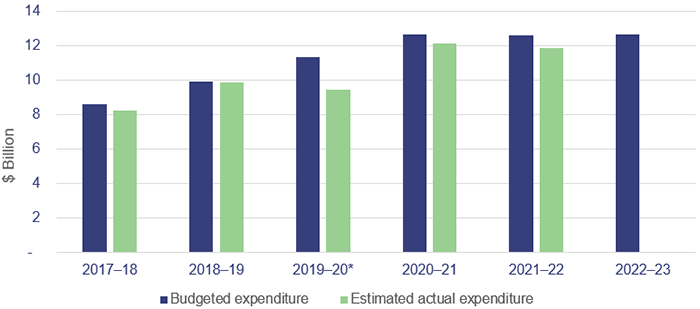
Note: * The estimated actual expenditure for 2019–20 was not disclosed in the capital statement for 2020–21 and was taken from the capital purchases from the non-financial public sector in the Report on State Finances 2019–20.
Compiled by the Queensland Audit Office from Budget Paper 3 – capital statement 2018–19 to 2022–23, and the Report on State Finances 2019–20.
Capital expenditure across Queensland's regions
Major projects can take several years to design and construct, and spending on major projects is a long‑term investment. The assets these projects deliver are intended to last and to provide services for decades. Because of this, investment decisions made today need to anticipate the state’s future population demographics and service needs.
In the next 20 years, Queensland’s population is estimated to increase to between 6 and 8 million people – an increase of 24 to 48 per cent. As the population grows, the demand for services increases, putting pressure on assets used for health, education, transport, and energy. The government will need to continue to invest in infrastructure.
Queensland’s regions are expected to grow at different rates, with large growth expected in South East Queensland, but lower growth expected in the rest of Queensland over the same 20-year period.
Figure 1C shows the average capital expenditure included in the state budget from 2018–19 to 2022–23 for each region, and the same capital expenditure by the number of people in each region as of 30 June 2021 (the regions are depicted on a map of Queensland in Appendix D). Some of these projects are funded by both the Queensland and Australian governments.
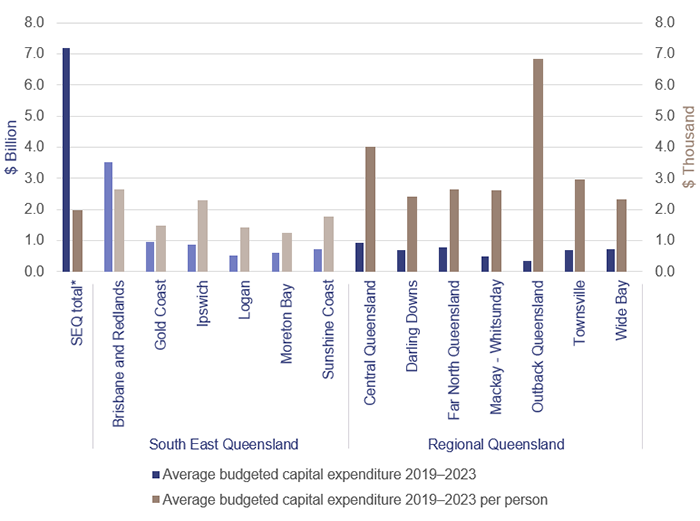
Notes:
* Capital expenditure has been shown for South East Queensland as a whole, as well as the 6 regions within that area. This is because of the interconnected nature of many of the projects within that area, with individual projects benefiting people across multiple regions, for example, upgrades to the M1 Pacific Motorway.
SEQ – South East Queensland.
Compiled by the Queensland Audit Office from Budget Paper 3 – capital statement 2018–19 to 2022–23, and data from the Australian Bureau of Statistics – Regional population estimates.
Projects in Brisbane and Redlands (including the Cross River Rail) account for 30 per cent of the capital expenditure. The higher capital expenditure in South East Queensland generally reflects the higher population in that area, and the higher growth expected for that area over the next 20 years.
Most capital expenditure is on transport and main roads
Figure 1D shows the value of capital projects across government portfolios by budgeted capital expenditure, from 2018–19 to 2022–23. Of these, 46 per cent of the costs (and 22 per cent of the projects) are in the Transport and Main Roads portfolio. Appendix C lists the entities included in each portfolio.
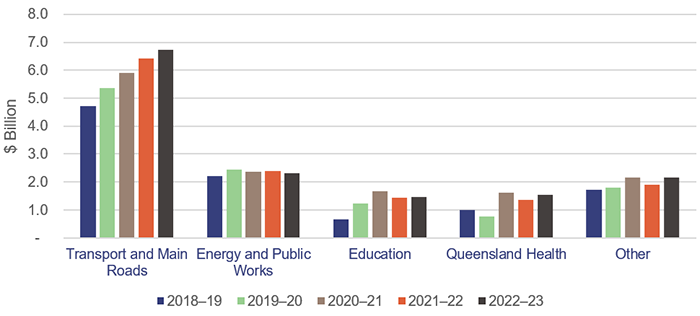
Compiled by the Queensland Audit Office from Budget Paper 3 – capital statement 2018–19 to 2022–23.
Of the capital projects, there are 12 with total estimated costs greater than $1 billion. They include the Cross River Rail project, New Generation Rollingstock (electric trains), and electricity network replacements. Of the 12 projects, 9 come under the Transport and Main Roads portfolio.
Figure 1E provides a summary of the Queensland Government’s budgeted capital expenditure and top 5 projects for each year from 2018–19 to 2022–23. This shows what the government planned to spend each year on new and continuing capital projects.
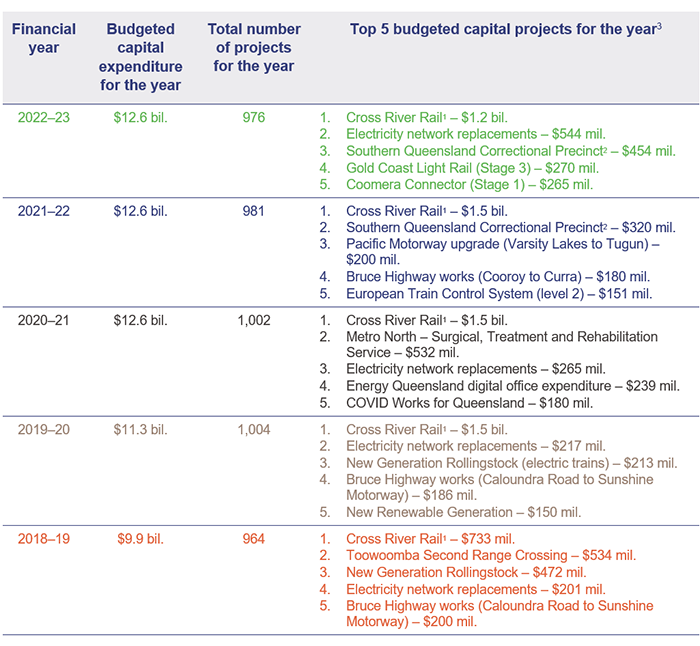
Notes:
- The Cross River Rail project is reviewed in further detail in Chapter 2.
- We reviewed this project as part of Contract management for new infrastructure (Report 16: 2021–22).
- Annual budget amounts for maintenance and minor works programs that include multiple projects (for example, maintenance of roads and rail networks across Queensland’s regions) were excluded from the top 5 projects.
Compiled by the Queensland Audit Office from Budget Paper 3 – capital statement 2018–19 to 2022–23 information on the Queensland Government’s Open Data website.
Projects underway as of 30 June 2022
Figure 1F outlines the Queensland Government’s major projects (those costing more than $500 million) as of 30 June 2022, with their expected completion dates and total estimated costs.
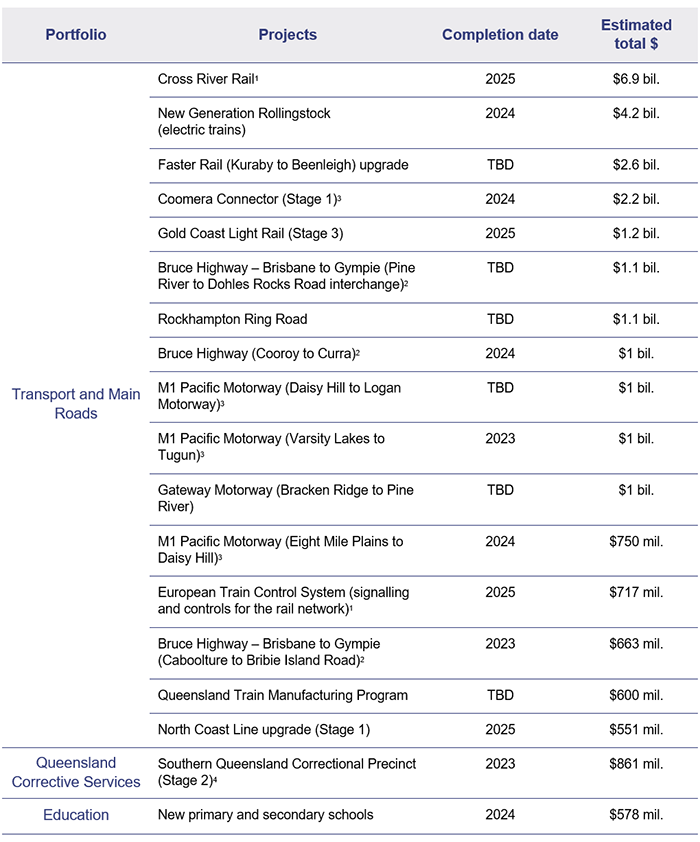
Notes:
- These projects are reviewed in further detail in Chapter 2.
- These projects are part of the Bruce Highway upgrade program.
- These projects are part of the Pacific Motorway M1 upgrade program.
- We reviewed this project as part of Contract management for new infrastructure (Report 16: 2021–22).
- TBD – to be determined.
Compiled by the Queensland Audit Office from Budget Paper 3 – capital statement 2022–23.
Roads
The Department of Transport and Main Road’s (DTMR's) Bruce Highway upgrade program outlines $13 billion of works over a 15-year period (2013–14 to 2027–28). This includes over 500 individual projects targeted at improving the safety, flood immunity, and capacity of the highway.
DTMR’s Pacific Motorway M1 upgrade program outlines a total investment of $5.2 billion. To date, 7 projects have been completed.
The Gateway Motorway upgrade does not have a current completion date in the 2022–23 capital budget statements. The business case for this is currently being developed and is due to be finalised in 2023.
Rail
Extending an existing commitment (of $600 million) to build trains in Maryborough, the Queensland Government committed a total of $7.1 billion as part of the 2022–23 Queensland state budget to boost train manufacturing and deliver 65 trains within the next decade. The additional funding includes a purpose-built manufacturing facility to be constructed at Torbanlea (north-west of Maryborough), new rail infrastructure in the south-east of the state, and ongoing maintenance of the new fleet. This will be subject to the outcomes of a competitive procurement process.
The New Generation Rollingstock project is a 32‑year contractual arrangement with the private sector for the design, construction, and maintenance of 75 new 6‑car train sets and a new maintenance centre. All 75 train sets were delivered by December 2019 with ongoing payments made over the contract period. Rectification of the trains to meet accessibility requirements is a separate project, with $112 million budgeted in 2022–23, and is expected to be completed by 2024.
Gold Coast Light Rail
Released in 2013 by the Council of the City of Gold Coast, the Gold Coast Transport Strategy 2031 is guiding the design of the city’s transport system. One of the key targets is to have a balanced transport system that gets people off roads and around the Gold Coast in a more sustainable way. The Gold Coast Light Rail (GCLR) is being delivered in stages. It is currently a single line more than 20 kilometres long and has 19 stations from Helensvale to Broadbeach South.
Stage 3 involves a 6.7‑kilometre southern extension of the existing light rail network from Broadbeach South to Burleigh Heads, including 8 new stations and 5 additional trams.
GoldlinQ has been contracted by the state government to design, construct, operate, and maintain the system. The major works contract for Stage 3 was originally expected to be awarded in late 2020, with John Holland announced as the preferred supplier. However, the finalisation of the contract was delayed as the parties negotiated the application of the Best Practice Industry Conditions for Transport Civil Construction Projects, released by the Department of Transport and Main Roads in December 2020. The GCLR Stage 3 major works contract was signed in March 2022. Major works on the project commenced in July 2022.
The Council of the City of Gold Coast has been partnering with both the Australian and Queensland governments to fund the delivery of the light rail network. The total indicative budget for GCLR Stage 3, as published by the Department of Transport and Main Roads in its Queensland Transport and Roads Infrastructure Program 2022–23 to 2025–26, is $1.2 billion. The Australian Government has committed $395.6 million, the Queensland Government $713.3 million, and the council $120 million. This is an increase of $175 million on the indicative budget published in the Queensland Transport and Roads Infrastructure Program 2021–22 to 2024–25, with the Queensland Government providing the additional funding.
GCLR Stage 4 is a 13-kilometre extension south of the GCLR Stage 3, linking Burleigh Heads to Coolangatta via the Gold Coast Airport. The council is currently working with the state government on early planning for this stage. The preliminary business case is expected to be completed mid-2023.
The Gold Coast Transport Strategy 2031 also proposes future extensions of the light rail network, with a network of 4 lines by 2031.
Brisbane-based projects that are not included in the Queensland Government budget
Major projects are not solely delivered by the Queensland Government. Councils are integral in the delivery of services to their community, and this can include significant infrastructure planning and delivery.
Some projects are also delivered through partnerships with the private sector. This can take different forms, with responsibility for construction, ownership, maintenance and operation of assets varying between private and government entities.
Brisbane Metro
The Brisbane Metro project is currently the largest infrastructure project being constructed by Brisbane City Council. The council and the Australian Government will fund the project, which has an estimated cost of $1.5 billion. It will be constructed over a number of financial years, and we will continue to audit and report on it.
In October 2020, the council awarded the contract to the Brisbane Move consortium. Brisbane Move is partnering with the council to design and deliver major infrastructure works for the project, which began in late 2021.
The Brisbane Metro will transform 21 kilometres of existing busway into high-frequency rapid-transit transport between Eight Mile Plains and Roma Street, and between the Royal Brisbane and Women's Hospital and the University of Queensland. It will connect 18 stations, of which 11 will be interchange stations linking the metro to bus routes, with 2 linking to Cross River Rail stations. The project includes the delivery of a new fleet of 60 all-electric high-capacity metros (battery-electric vehicles).
Figure 1G provides a snapshot of the Brisbane Metro project, including total funding and expenditure as of 30 June 2022.

Compiled by the Queensland Audit Office.
The project includes 3 main work packages. Figure 1H provides information on activities under each of these, as well as the total budgeted and actual expenditure as of 30 June 2022.
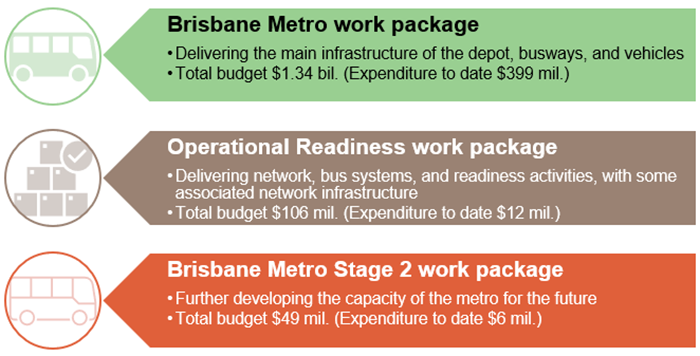
Brisbane City Council project budget.
Increase in budget
In June 2021, the budget was changed from $1.4 billion to $1.5 billion. This increase was needed to deliver additional infrastructure required by the Queensland Government as part of its approval of the project.
To link in with existing infrastructure, Brisbane City Council added in additional work of $83 million to upgrade the Buranda busway station, carry out additional work on the Griffith busway station, and upgrade a park in Grey Street outside South Brisbane station. To help alleviate the construction impacts, Brisbane City Council is also investing in a toll credit scheme (a scheme to provide subsidised travel) for use on Brisbane’s Go Between Bridge for local residents.
Australian Government contribution
There are legislative limitations on funding that is distributed from the Australian Government to local governments. This means an inter-government project agreement needs to be completed before the transfer of funds can occur. Brisbane City Council and the Queensland Government, through the Department of Transport and Main Roads, entered into a funding agreement in June 2022. This has enabled Australian Government funding to be provided to the council, with $170 million of the $300 million paid to date.
Current progress
The metro and its charging system are the first of their kind in Australia, and because of this, testing and commissioning activities need to be completed. A pilot metro (battery-electric vehicle) arrived in Brisbane in 2022 for testing. Following the successful trial of the pilot, Brisbane City Council placed an order for the initial fleet of a further 59 vehicles.
Main construction works began in late 2021. The Brisbane Metro depot is expected to be complete by 2023, with Brisbane Metro vehicles in operation by late 2023 (subject to approvals). Completion of stage 1 of the project is expected in late 2024. Figure 1I provides a timeline of key milestones.

Compiled by the Queensland Audit Office from information on Brisbane City Council website.
Queen’s Wharf Brisbane
The Queen’s Wharf Brisbane Integrated Resort project is being developed through private enterprise and has significant public interest due to the location, size, and type of the project.
On 16 November 2015, the Queensland Government entered into contractual arrangements with the Destination Brisbane Consortium (the consortium) to redevelop the Queen’s Wharf Brisbane precinct in the centre of Brisbane. The majority of the land and buildings in the precinct are owned by the Department of Energy and Public Works. From 22 February 2018, the site was leased to the consortium under a development lease to enable construction. Upon completion, a long-term lease will be entered into for 99 years. The consortium is responsible for the construction of the precinct, and so the capital expenditure is not included in the Queensland Government’s budget.
In previous reports to parliament, we have reported on the accounting for the lease of the land on which the project is being constructed.
Figure 1J shows key milestones for the Queen’s Wharf project.

Queensland Audit Office from Destination Brisbane Consortium website.
A principle of the contractual arrangements is that the consortium will be granted a casino licence. This occurred in 2016. An external review of the Queensland operations of a particular member of the consortium under the Casino Control Act 1982 (Qld) by the Hon. Robert Gotterson AO KC has been undertaken, with the report provided on 30 September 2022.
This report concluded that the 2 casinos presently operated by this member in Queensland have been operated in a way that is inconsistent with the achievement of the objectives of the legislation. This indicates the unsuitability of the member to hold licenses for their 2 existing Queensland casinos and by association the unsuitability of the consortium to hold a licence. The findings and recommendations of this report have been agreed in-principle by the Queensland Government.
Because the project is being developed by a private consortium, it is intended that the construction risks of the project (for example, increases in costs or delays in the supply of materials) will remain with the private entity and not the state. In our Forward work plan 2022–25 we have included an audit for tabling in 2024–25 on Managing risk transfer in infrastructure projects. It will examine how effectively public sector entities are identifying, managing, and transferring risks.
Brisbane 2032 Olympic and Paralympic Games infrastructure
On 21 July 2021, the International Olympic Committee announced Brisbane as the host city for the 2032 Olympic and Paralympic Games. The cost of hosting the Games is expected to be cost-neutral, with estimated event costs of $4.9 billion (estimated in 2021 in Australian dollars) to be funded through revenue from the Games.
There will be additional costs that include state government services, Games venues and villages, and legacy and festival programs. These costs continue to be assessed, with an initial estimate of $1 billion announced for The Gabba stadium redevelopment. In its State Infrastructure Strategy, the Queensland Government states that the Games are estimated to bring economic and social benefits valued at $8.1 billion for Queensland and $17.6 billion for Australia.
Brisbane will need to have appropriate infrastructure in place to deliver the Games efficiently and economically. In the Brisbane 2032 Master Plan, the Queensland Government has stated that it is planning to use existing and temporary infrastructure as much as possible. Of the venues identified in the master plan, 84 per cent are existing or temporary. Some may require improvement and redevelopment, including The Gabba stadium.
The master plan also includes 6 projects aligning with long-term development plans and anticipated growth patterns of the region. This includes 4 new indoor sports centres, the Redland Whitewater Centre, and the Brisbane Arena (formerly the subject of the Brisbane Live business case). The athletes will be housed in villages in Brisbane and on the Gold and Sunshine coasts. With The Gabba having been declared as the main venue for the Games, redevelopment of the stadium is being assessed to increase seating capacity from 42,000 to 50,000.
A number of other projects are being undertaken and considered by the Queensland Government and Brisbane City Council to continue to build the region for the future. These projects will also be critical to the Games, for example, the development of the Woolloongabba Station Precinct as part of Cross River Rail.
The Queensland Government’s 2022–23 budget did not include significant capital expenditure for the Games. As the detailed planning for these venues progresses, information on costs and timing will be reflected in future budgets. As the Games plan starts to take shape, we will continue to report on the progress of future projects in our various reports to parliament.
Brisbane Live proposal
The Brisbane Live proposal originated from a market-led proposal process (a proposal from the private sector that seeks an exclusive commercial arrangement with government to deliver a service or infrastructure to meet a community need). Our report Evaluating major infrastructure projects (Report 14: 2019–20) reviewed the business case development of several projects, including the Brisbane Live arena at Roma Street.
The report noted that when Building Queensland (which was subsequently abolished on 2 June 2021 and the functions and staff transferred to the Department of State Development, Infrastructure, Local Government and Planning) endorsed the business case, it advised there were areas that required further analysis before the project was market ready. The department has commenced a project validation report to determine the site where the arena will be located. Following the completion of the report, an investment decision will be made.
The Brisbane 2032 Master Plan indicates a pool will be temporarily constructed in the arena.
South East Queensland City Deal
The Australian Government has announced in its 2022–23 budget it will provide $363.9 million over 4 years to support a number of projects as part of the South East Queensland City Deal. This will help prepare South East Queensland for the 2032 Games. The deal was signed by the Australian Government, Queensland Government, and the South East Queensland Council of Mayors on 21 March 2022.
The projects include a Brisbane to Sunshine Coast (Beerwah to Maroochydore) rail extension; an upgrade to the Kuraby to Beenleigh rail (the Faster Rail project); and a number of road projects, including the Outback Way upgrade (also known as ‘Australia’s longest shortcut’) which runs from Laverton in Western Australia to Winton in Queensland.

2. Review of the Cross River Rail project
The Cross River Rail (CRR) project is being delivered by the Cross River Rail Delivery Authority (the Delivery Authority) and is the largest single infrastructure project currently under construction in Queensland. It is budgeted to cost $6.888 billion and as of 30 June 2022, $4.6 billion had been spent on it.
The project is made up of 10.2 kilometres of new rail infrastructure from Dutton Park to Bowen Hills, including 5.9 kilometres of twin tunnels under the Brisbane River and Central Business District and 4 new underground stations – Woolloongabba, Boggo Road, Albert Street, and Roma Street. It will also deliver upgrades to 8 above-ground stations – Salisbury, Rocklea, Moorooka, Yeerongpilly, Yeronga, Fairfield, Dutton Park, and Exhibition.
In addition to the CRR project, the Delivery Authority is responsible for a wide range of CRR‑related work, including introducing the European Train Control System (an advanced signalling system) for the whole of South East Queensland.
The state, through Queensland Rail and the Department of Transport and Main Roads, is also delivering major rail-related projects.
Due to the size and complexity of the projects, there is a heightened degree of scrutiny by stakeholders, including of the effectiveness of the procurement activities undertaken by the Delivery Authority in delivering the CRR project.
Given this level of public interest, we have performed an independent review of the business cases supporting the investment decisions to enter into the project and the Delivery Authority’s major procurement activities. In this chapter we also provide an overview of the CRR project, and discuss progress, costs, and funding estimates.
Progress of the Cross River Rail is affected by supply chain issues
The project is expected to cost $6.888 billion and is funded through $5.389 billion of state contributions and $1.499 billion in private finance contributions. A total of $4.6 billion (67 per cent of the project budget) had been spent on the CRR project by the Delivery Authority as of 30 June 2022. As a result of market forces and schedule adjustments, the actual amount spent to date is about $452 million (9 per cent) less than the projected expenditure for the CRR budget. Expenditure on other projects being undertaken on behalf of Queensland Rail and the Department of Transport and Main Roads is also $200 million less than projected.
The project is being delivered at a time when a lot of public infrastructure is being constructed all over Australia, causing competition for resources. High rainfall, the Ukraine conflict, and the COVID-19 pandemic have also affected the delivery of the project. These factors have delayed supply and increased the costs of materials and the workforce.
To mitigate some of these factors, the Delivery Authority and its contractors have pre-ordered long lead‑time materials, increased their workforces, rescheduled work programs, and extended working hours to deliver the project. The Delivery Authority has been monitoring these impacts since early 2022 and working with all stakeholders to determine strategies to deal with potential effects on time and cost.
The Delivery Authority will need to continue to monitor performance and budget, and adjust for impacts relating to the supply chain and consequential pricing outcomes.
Cross River Rail – expected costs and funding
The $6.888 billion CRR budget has 3 components: Tunnel, Stations and Development; Rail, Integration and Systems; and other works such as land acquisitions.
The Delivery Authority is also undertaking several other related projects for the Department of Transport and Main Roads and Queensland Rail, to maximise efficiencies while contractors are already working in the rail corridor. Broadly, these include safety upgrades, accessibility improvements, asset replacements, and changes to facilitate SEQ Rail Connect (a strategy to deliver a single, integrated transport network accessible to everyone in the growing South East Queensland (SEQ) region). Specifically, these include upgrades to train stabling yards, bridges, and stations (called ‘complementary and associated works’ – $761 million) and the implementation of the European Train Control System ($764 million).
The projects and their funding sources are outlined in Figure 2A.
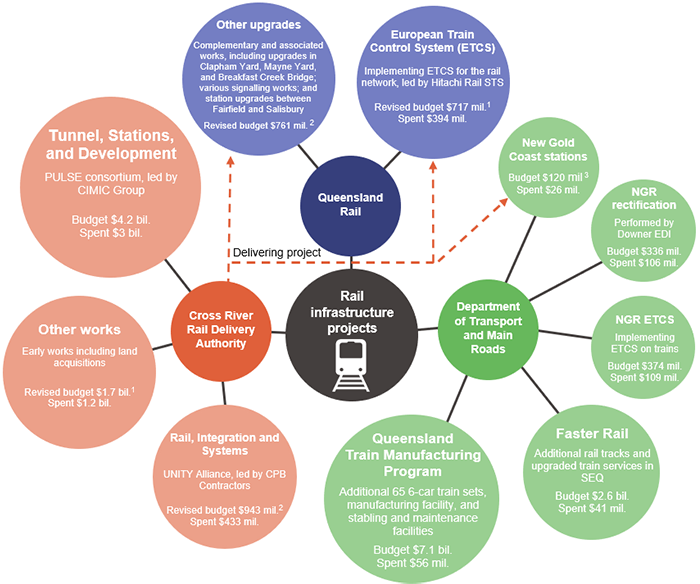
Notes:
- The total budget for the ETCS work package is $764 million, with Queensland Rail funding $717.3 million and the Delivery Authority funding $46.8 million from the Other works budget.
- The total budget for the Rail, Integration and Systems work package is $1.7 billion, with Queensland Rail funding $761 million and the Delivery Authority funding $943 million.
- The total budget for New Gold Coast stations is $187 million, with the Department of Transport and Main Roads funding $120 million, and Queensland Rail funding $67 million.
- NGR – New Generation Rollingstock.
Compiled by the Queensland Audit Office.
Funding for design modifications and other project changes
Scope and design changes to major projects can occur as issues arise during the planning, design, and construction phases. Common risks that can result in modifications include defective or erroneous designs, latent conditions (a physical condition on or near the construction site that could not reasonably have been anticipated, for example, the discovery of soil contamination), ineffective integration of sub‑projects, and substandard quality of work by the engaged contractors. All budgets for major projects include a contingency to allow for these risks to be addressed as they arise, but this budget needs to be carefully managed.
As of 30 June 2022, the contingency for the CRR project remained within budget.
The Cross River Rail project has 3 major works packages
The CRR project is progressing through the design and construction phase. The Delivery Authority is monitoring external impacts on the costs and time frames of the project, and developing strategies to mitigate these impacts. It is delivering 3 major works packages:
- Tunnel, Stations and Development (TSD) – $4.2 billion
- Rail, Integration and Systems (RIS) – $1.7 billion
- European Train Control System (ETCS) – $764 million.
A component of the RIS project is called the complementary and associated works package, which is being separately funded by Queensland Rail as this work relates to the broader rail network. Queensland Rail is also funding $717.3 million of the ETCS package as it also relates to the broader rail network, with $46.8 million funded by the Delivery Authority.
The 3 major works packages are outlined in the following pages.
Tunnel, Stations and Development – $4.2 billion
Tunnel, Stations and Development (TSD) is the largest work package, and includes the boring of the twin tunnels, construction of each of the underground stations, and related works.
|
Public–private partnership with Pulse Consortium: Public–private partnerships are cooperative agreements generally entered into with private sector entities for the delivery of government services. The Tunnels, Stations and Development work package includes the design and construction phase over the 5-year construction period, and a 25-year agreement for ongoing maintenance services when the CRR becomes operational from mid-2025. State funding of $2.7 billion. Private finance contributions of $1.499 billion. |
Queensland Audit Office from Cross River Rail Delivery Authority management reports.

Compiled by the Queensland Audit Office.
Rail, Integration and Systems – $1.7 billion
The Rail, Integration and Systems (RIS) work package will integrate the CRR project with the existing train network. This will include electrical works and operation systems and controls, as well as signalling and communications work. It will also deliver upgrades to the accessibility (for people with a disability) of 6 suburban stations.
|
Alliance contract with UNITY (an alliance agreement is a multi-party contract, in which all parties agree to a single set of terms and conditions to deliver the project and share the risks of the success or failure of the project). Project budget of $1.7 billion. Delivered by the Cross River Rail Delivery Authority. Funded by Queensland Rail ($761 million) and Cross River Rail Delivery Authority ($943 million). |
Queensland Audit Office from Cross River Rail Delivery Authority management reports.

Compiled by the Queensland Audit Office.
In October 2021, a major design modification was made relating to the tunnel structure and the southern tunnel entrance. There were issues relating to the track geometry (for example, the curve of the track) and platform gaps, which were addressed by realigning the track to fit with the modified design and changing the location at which the southern tunnel surfaces from the original site in Yeerongpilly to the current site in Dutton Park.
The redesign increased the cost to the Delivery Authority of the Rail, Integration and Systems work package and the Tunnel, Stations and Development work package by approximately 3 per cent of the combined RIS and TSD budget. This is being met from the project’s contingency.
As part of the redesign of the southern area modifications, consideration was given to the location of the station, with 2 options considered. Both were assessed as appropriate, with advantages and disadvantages. We reviewed all documents associated with this assessment and decision and did not identify any matters of significance relating to the assessment of the options or the decision on station location.
European Train Control System – $764 million
The European Train Control System (ETCS) work package will deliver an advanced signalling system providing continuous information on the position, direction, and speed of all trains. It will also allow passengers to have access to real-time (as it is happening) information on train schedules. ETCS is required for the operation of the CRR tunnels and for the wider South East Queensland rail network.
|
Alliance agreement with Hitachi Rail STS. Project budget of $764 million, renegotiated from $646 million due to the addition of upgrades to increase the capacity of conventional signalling for specific areas. Delivered by the Cross River Rail Delivery Authority. Funded by Queensland Rail. |
Queensland Audit Office from Cross River Rail Delivery Authority management reports.

Compiled by the Queensland Audit Office.
The contract was initially awarded to Hitachi Rail STS as a fixed priced contract but was later negotiated to a collaborative contracting model (an alliance agreement). This was done to incentivise delivery and improve coordination and risk management between all parties involved in delivering the project.
The alliance agreement includes the original scope requirements for designing, building, installing, testing, and commissioning the signalling system for an operational CRR line from the northern tunnel portal to the southern tunnel portal. It also includes an upgrade to the capacity of conventional signalling for the Northern and Mayne areas (including the Exhibition, Mayne East, and Albion stations).
The new alliance contract outlines provisions to deliver future rail projects requiring ETCS deployment. Decisions on this are made by the Department of Transport and Main Roads as the project sponsor, or as part of the preparation for an Olympic-ready high-capacity railway. Any additional scope is expected to be contracted as required and as funding becomes available.
We did not identify any significant issues relating to procurement processes
Procurement processes across all Queensland public sector entities are guided by various Queensland Government policies and legislative frameworks.
We have reviewed the Delivery Authority’s procurement activities for each of the 3 major work packages and have not identified any significant issues relating to these.
The procurement activities we assessed included:
- early works activities, including assessing procurement plans, developing project specifications, and appointing and using probity advisors (who provide advice and assistance before and during procurement processes)
- contractor tendering processes and the evaluating of prospective bids
- contractor negotiating processes and contract signing.
Our review also considered whether contract management plans were developed to monitor ongoing contract deliverables and outcomes.
We have not assessed the effectiveness of the contract management processes implemented relating to the 3 major work packages as part of this review. We have also not assessed the merits of the project or whether it represents value for money.
Business cases supporting Cross River Rail project investment decisions
We have assessed the 3 detailed business cases prepared for the CRR project.
Business cases are used by governments to make good, informed decisions on major investments. Prepared after opportunities or problems are identified and potential response options are analysed, they document and calculate the expected benefits, impacts, and costs. They should provide clear, comprehensive evidence for decision-makers.
Business cases also include projections and assumptions, which can change over time. For the CRR project, 3 detailed business cases have been prepared:
- the original, finalised in September 2011
- an updated detailed business case, finalised in June 2016, including a major design change to reduce the length of the tunnels from 10 kilometres to 5.9 kilometres
- an updated business case, released publicly in August 2017, including increases in rail network capacity, decreases in rail fare prices, and an extension of 10 years to the timeline to achieve project benefits.
We assessed the business cases against the frameworks and guidelines that were relevant at the time they were prepared. We did not identify any significant issues in relation to their compliance with these frameworks and guidelines.
Forecasted benefits exceed costs in the detailed business cases
The Queensland Government decided to proceed with the CRR project based on forecasted benefits being greater than costs, in what is known as a benefit-cost ratio. These ratios are based on complex calculations containing significant assumptions and estimation techniques regarding a project’s forecast benefits and costs.
Each of the 3 business cases indicated that benefits exceed costs. They also contained sensitivity analyses (investigations of potential changes and their impacts on conclusions) that produced a range of different benefit-cost ratios, all of which indicated a positive outcome.
Sensitivity analysis in the 2016 detailed business case model forecasts indicated that the project will continue to have a positive benefit-cost ratio unless costs increase by more than 20 per cent and benefits decrease by more than 20 per cent. A delay in the project delivery will also impact on the ratio. An overrun of 2 years would affect the results.
We reviewed the June 2016 business case in detail (this business case had the most detailed analysis, with the 2017 business case being an update for changes in estimates and assumptions). The key measures and assumptions outlined in it include population forecasts, rail patronage growth, road user benefits, and construction costs.
The COVID-19 pandemic has impacted on working arrangements, with many people still working from home and not needing to travel. Queensland has also experienced significant population growth in recent years, and this is expected to continue in the lead-up to the Brisbane 2032 Olympic and Paralympic Games. These factors are both likely to impact rail patronage and any consequential impact on road usage.
The business case projected that the daily rail passenger usage in South East Queensland with the operation of CRR would increase by 103 per cent over the period from 2015 to 2026 (an average increase of 6.65 per cent per annum). The actual Queensland Rail Citytrain Network Passenger trips (pre-CRR) data shows the increase in passenger trips for the 4 years from 2015 to 2019 was only 6.6 per cent (an average of 1.6 per cent per annum). Our report Transport 2021 (Report 10: 2021–22) noted rail passenger numbers reduced by 25.3 per cent in 2020–21 due to the COVID-19 pandemic. In recent months, rail passenger numbers have started to slowly improve. There will need to be a significant increase in passenger trips over time for the forecast benefits of the project to be achieved.
Another measure of success in the business case related to road user (or 'decongestion') benefits. This is tied to the shift of transport mode from road to rail, which frees up road space in congested areas and provides a reduction in costs associated with vehicle operation and with crashes. In the business case, road user benefits represent $3.6 billion (64.7 per cent of the benefits in the 2016 detailed business case) of the total projected benefits of the project.
Plan to achieve intended benefits over time
Queensland Treasury’s Project Assessment Framework requires that appropriate plans be developed and implemented for the commissioning of a project, to ensure the intended benefits are achieved over time. This involves reviewing and updating the business case to reflect current financial and non-financial information. In the framework, this stage is referred to as ‘Establish service capability’, which is a precursor to proceeding to the ‘Deliver service’ stage of the framework.
In August 2022, the Department of Transport and Main Roads released SEQ Rail Connect – a strategy to deliver a single, integrated transport network accessible to everyone in the growing South East Queensland region. A focus of the strategy is getting ready for Cross River Rail.
The expected benefits of the CRR project should continue to be monitored, and appropriate transport and other strategies implemented, to maximise rail patronage and road user benefits over the medium and long term.

